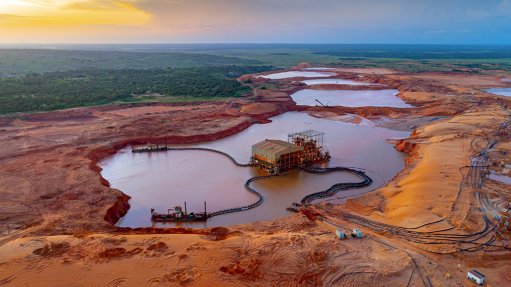
WCP A Kenmare’s prefeasibility study includes the installation of a desliming circuit on wet concentrator plant A to mine Nataka ore more efficiently
Mineral sands producer Kenmare Resources is ramping up ilmenite production to 1.2-million tonnes a year, on a sustainable basis, with the company having produced 1.09-million tonnes of ilmenite in 2022.
The company expects its Moma titanium minerals mine, in Mozambique, to produce between 1.05-million and 1.15-million tonnes of ilmenite this year, and plans to transition the wet concentrator plant (WCP) A to the Nataka ore zone in 2025. WCP C is also scheduled to be relocated to the Nataka ore zone in 2030.
“We work hard to uncover, assess and develop other value accretive projects to deliver growth,” says corporate development and investor relations head Jeremy Dibb.
Kenmare is also continuing work on its prefeasibility study (PFS) for the Nataka ore zone that contains 79% of the Moma mine’s 6.3-billion tonnes of mineral resources.
The PFS includes the installation of a desliming circuit on WCP A to mine Nataka’s ore more efficiently, says Dibb, adding that a cost-benefit analysis is being conducted to investigate the acceleration of the installation of the desliming circuit ahead of WCP A being moved.
“This has the potential to increase the effective WCP capacity and, in turn, better mitigate against the slime levels at the end of the current mine path within the Namalope ore zone,” he explains.
While Kenmare is expected to provide an update on the progress of the PFS next month, Dibb says initial estimates suggest that the capital cost of the WCP A move is unlikely to be less than $225-million.
Overcoming Challenges
As new world-class ore deposits become more costly to find, finance and develop, Kenmare had to deal with supply constraints for all its mineral sands products.
Despite these constraints, Dibb describes 2022 as a “strong year” for Kenmare’s production markets, resulting in record average prices received for all products, and enabling the company to move to a net cash position of $27.5-million at the end of 2022.
This represents a $110.3-million improvement from 2021, which was achieved while also paying record dividends during the period. Kenmare continues to target a total dividend payment of 25% of profit after tax for 2022.
“We constantly assess the best ways of deploying the capital generated from our activities,” says Dibb.
The global titanium feedstocks industry has yearly revenues of about $4.5-billion, with production from Kenmare’s Moma mine representing about 7% of global titanium feedstock supply.
Long-term demand for titanium feedstocks is linked to global economic growth, with future demand growth underpinned by developing economies with large populations and relatively low titanium dioxide pigment consumption per capita, compared to that of developed western economies, adds Dibb.
Meanwhile, the global zircon industry revenues are worth $1.7-billion yearly.
“Despite some macroeconomic headwinds, we continue to see a robust market for our products, with strong pricing achieved in the last quarter of 2022. As China further relaxes Covid-19 restrictions, we expect higher domestic demand to support our sales in the region,” adds Kenmare MD Michael Carvill.
Sustainability Initiatives
In light of energy constraints in Mozambique, Kenmare introduced a rotary uninterruptible power supply (RUPS), valued at $20-million, for its operations in May last year.
“The objective of the RUPS is to improve power stability at the mine’s mineral separation plant and, in turn, make a significant contribution to Kenmare’s goal of further reducing its greenhouse-gas emissions by 12% by 2024,” says Dibb.
He comments that, since becoming operational, the RUPS has been successful at mitigating electricity supply disruptions while helping the company achieve its net-zero goals on Scope 1 and Scope 2 emissions by 2040.
The company also aims to achieve a balance between the needs of its host communities, environmental conservation and economic returns.
“We aim to deliver increased value to Kenmare's shareholders and our host country, Mozambique, and work towards a safe and engaged workforce, thriving communities, a healthy natural environment and being a trusted business,” says Dibb.
With Kenmare having invested early in connecting to the Mozambican grid – which supplies the Moma mine with low-carbon, hydroelectric power – Dibb says it will be challenging to embark on further decarbonisation initiatives, considering the company has already achieved significant low emissions.
The company also emphasises environmental, social and corporate governance (ESG) in its approach to responsible mining and its social licence to operate in Mozambique.
Dibb notes that, after exceeding 18 months of lost-time injury-free operation, three lost-time injuries were recorded from January to December 2022, resulting in a rolling 12-month lost-time injury frequency rate of 0.09 per 200 000 hours worked, compared to its three-year average of 0.14 from 2020 to 2022.
Nonetheless, Kenmare is redoubling efforts to ensure consistent observance of good safety practices.
“Our workforce is the company’s most valuable asset. Protecting the health, safety and wellbeing of all employees is a leading part of our approach to ESG and ensures that we effectively sustain our operations and enable our employees to return home safely every day,” concludes Dibb.